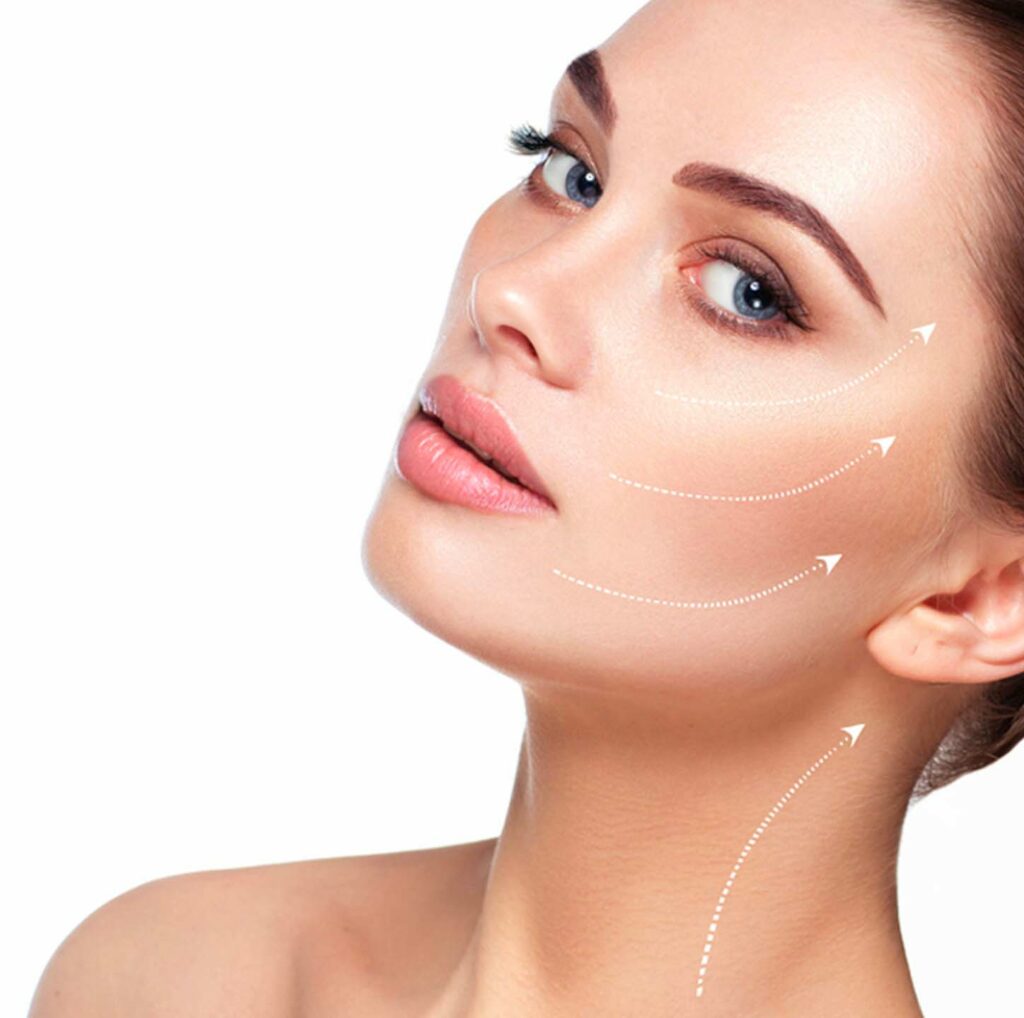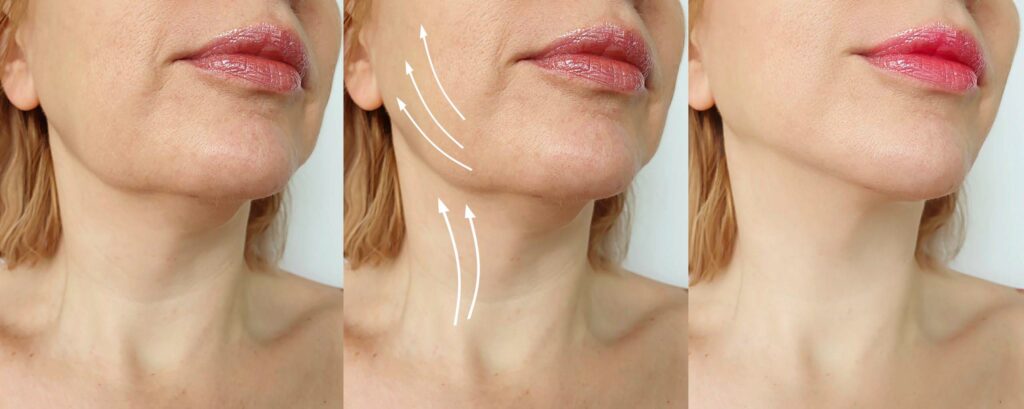Facelift Surgery
What is facelift surgery?
People age due to stress, genetics, overexposure to sunlight, bad habits (smoking, alcohol), and the nature of life. In this process, due to aging, our skin loses its elasticity and our muscles tend to relax. In general, the folds and smile lines deepen, the corners of the mouth droop, the jaw line droops, and the neck skin relaxes. Falls and wrinkles occur on the eyelids and eyebrows. Stretching surgery, on the other hand, is a rejuvenation operation that helps the patient have a younger and more beautiful appearance to prevent these wrinkles and sagging. During the operation, the phases of the skin are removed with an incision starting from the hairy part of the ear. In addition, upper and lower eyelids can be intervened during the operation, if there is atrophy in the facial tissue, fat injections can be made, and complementary procedures such as botox and peeling can be performed. This surgery does not stop the ongoing aging, but it can provide patients 5-10 years of rejuvenation.
Who are suitable candidates for a facelift?
Men and women with wrinkles and sagging problems in the face and neck area may be suitable candidates, but it works best if your skin still has some elasticity and your bone structure is strong and well defined. It is usually applied to people over the age of 40. However, in some cases, these surgeries can also be performed on younger people. Since it is a surgical intervention performed under general anesthesia, of course, your diseases, previous aesthetic operations, and the drugs you use are factors that affect your suitability for surgery. The medical history of the patients is questioned in detail by our doctors before the surgery. Along with facelift surgery, nose, eyelid aesthetics, forehead correction, and eyebrow lifting operations can also be performed at the same time.

Types of Face Lift Surgery
Mini Face Lift Surgery
Today, facelift operations can be applied by minimizing. Instead of performing surgery for a whole face, the technique is applied in the cheek area, where aging has just begun, around the age of 40-50. Since it is done at an early age, it is easier to stretch the skin that still has elasticity. During the surgery, it is aimed to stretch the cheek area. The operation performed under general anesthesia takes about 2 hours.
Mid-face Lift Surgery
Procedures are performed either through the incision in the lower lid during lower eyelid surgery, or endoscopically with the help of a short incision made from the scalp. Suitable for middle-aged people 40-55 years old. The aim in the midface area is to replace the soft tissue that has been lost, move the sagging structures up, and correct the deteriorated lower eyelid-cheek relationship.
Full-face Lift Surgery
It is more suitable for the slightly older population seeking more pronounced results. It is suitable for the average 55-60 age skin age group. Surgery is performed with an incision starting from the hairy skin border, and continuing in front of the ear, and ending behind the ear. The areas targeted by the incision are the cheeks, temples, and the upper part of the neck. In addition, the connective tissue called SMAS can be intervened during the surgery. A large part of the volumetrically loosened and sagging tissue is here. In fact, all these tissues are intervened with SMAS stretching. Although there is a slightly longer recovery period due to a longer procedure and deep incisions, the results are long-term and satisfactory. The operation is performed under general anesthesia and takes an average of 2-4 hour
Face Lift Techniques
MACS (Minimal Access cranial suspension) Face Lift
In this method, the surgeon works on a targeted basis with small incisions that do not go deep compared to classical methods. Since the incisions are small, the recovery time is short.
S-Lift
It is a method in which SMAS tissue suspension is performed after skin and subcutaneous tissue dissection with an incision made in front of the ear in the shape of the letter S.
SMAS Face Lift
The membrane-muscle composition that surrounds the deep structures of the face with the deeper incisions described above (buraya full facelift paragrafı bağlanacak) is based on the principle of stretching a tissue. Since the incisions are deep, the recovery time is long, but it is an effective method in terms of results.

What you can do for yourself in the pre-operative period
In the pre-operative period, the patient should first determine what he wants to do about the problems related to his face. It should be within realistic expectations and should explain these expectations in detail to the surgeon. The patient should present a detailed medical history about the drugs he used, the operations he had undergone, and his diseases. Before going into surgery, he should have detailed information about the risks and complications. Our recommendations before the procedure are as follows:
- Stop smoking, it will minimize the negative effects on wound healing
- Eat healthy and regularly. Exercise will speed up the recovery process after surgery. It may also make sense to lose weight. This allows the surgeon to remove more skin and achieve better results.
- If you are going to do chemical treatments such as perming, bleaching, or coloring your hair, do it before the operation.
- You can remove the hair in the surgical area, but make sure you keep it clean, if possible, take a shower 24 hours before the operation.
Time To Surgery: The surgery is performed under general anesthesia and local anesthesia within the scope of the techniques used. The anesthesia method varies according to the technique used. For example, mini facelift surgery is performed with local anesthesia and sedation (it is an anesthesia method in which patients do not feel pain and use their own respiratory muscles, it can be called sleepiness), while full facelift surgeries are performed under general anesthesia. Again, the duration of the operation may vary according to the surgical technique. You can review detailed information inside. It is recommended that patients stay overnight for the surgery. Face lift operations can be combined with procedures such as neck lift, eyebrow lift, eyelid aesthetics, as well as fat injection and peeling, according to the wishes of the patients.
Permanence time of Face Lift Surgery: The surgical procedure allows patients to look 5-10 years younger. Due to the nature of life in patients, the aging process will continue, but patients will look much younger than their non-operational state. If they pay attention to factors such as smoking, alcohol, unhealthy diet, sun rays, and insomnia that will accelerate the aging of the patient, the effects of the procedure can last up to 10 years. The image obtained with non-surgical facelift procedures, which is another option, is short-term and temporary.
Overview of the Post-Surgery Process
You must stay in the hospital for one day after surgery. Drainage tubes that drain any fluid and blood may be in your face. These tubes will be removed when the fluid or blood has stopped draining. You will be given antibiotics to keep the wound clean and painkillers for your pain. These pain relievers are for the pain and tension you will feel in your face and neck. You can be discharged from the hospital after 1 day.
Recovery Process
Swelling and Bruises
It is normal for your face to swell after the operation. After 72 hours the swelling becomes more prominent. You should keep your head high, and use a few pillows while lying down. Salt-free diets can be preferred in this process. 2 weeks after the operation, there is a significant decrease in swelling and bruising. It may take 6 months for your skin to look normal. At the end of 6 months, a 90% reduction of swelling may occur. Generally, at the end of a year, there is no swelling on your face, but these processes are patient-based. It may take a long time in some patients, while it may take a short time in some patients.
Bleeding
It’s normal to have some blood ooze out the seams and a small amount of tissue fluid leakage after the surgery. It is useful to consult your doctor in severe bleeding that does not stop within 10 minutes.
Dressing
It is normal to have dressings on your face and neck after surgery. The dressing will stay on for a day or two and if non-dissolving stitches are used, the stitches will be removed in 7-8 days. It is recommended that patients use a special face mask for at least 2 weeks after surgery. The person should protect his/her face from physical impacts and clothes while dressing.
Back to life and exercise?
You will be able to get out of bed the same day after your surgery and start exercising 2 weeks later. Avoid heavy lifting during this process and be careful not to tilt your head forward. Walking and non-physical activities should be preferred in this process.
Scars and healing
Whether or not there will be a scar after the operation is directly related to the surgical technique applied. For example, a traceless recovery is possible in micro and mini-procedure. However, the scars formed in more extensive procedures are hidden in the hairy skin in the temple area, in front of the ear, and behind the ear. In short, these scars are mostly invisible and can be hidden, but a good recovery and adequate blood circulation should not be smoked during the recovery period.

Seeing The Results
At first, your face and neck skin may seem very tight and swollen. This will resolve in about 6 weeks. Your face will take its final shape within 6-9 months after the surgery. In our experience, many of our patients are satisfied with the results.
Alternative methods for Face Lifting
Facelift and neck lift surgeries are the most effective ways to get rid of wrinkles and sagging skin, but some patients do not want to take the risks of surgery. These patients can benefit from non-surgical aesthetic interventions. Botox to get rid of wrinkles around the eyes, forehead, and mouth, peeling (laser, chemical, mechanical), mesotherapy, and PRP applications to look younger and more beautiful can also be considered. Please click for detailed information.
